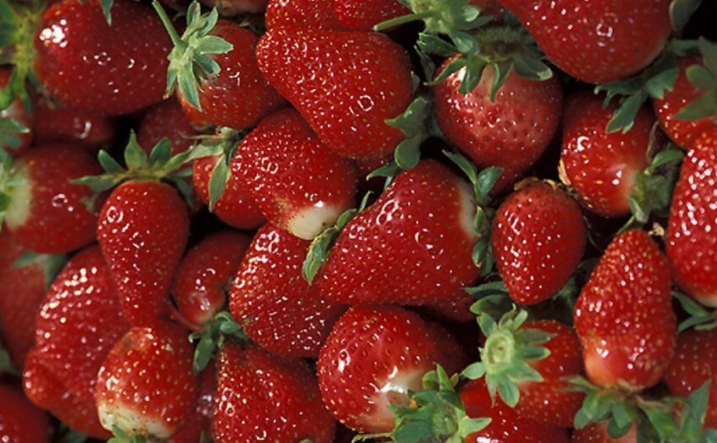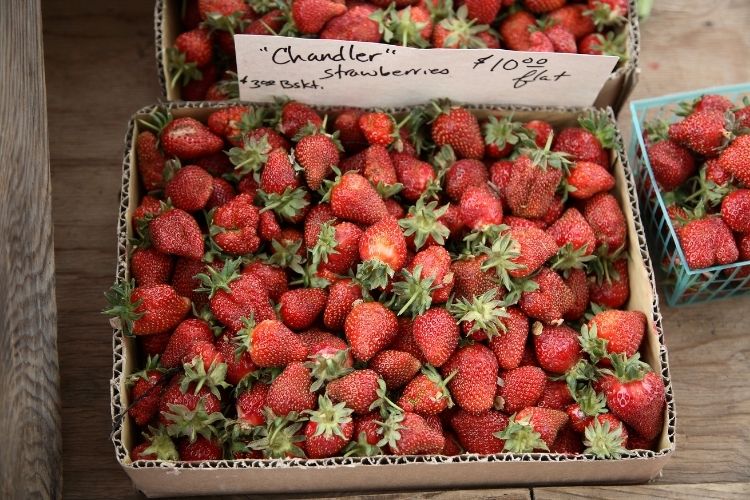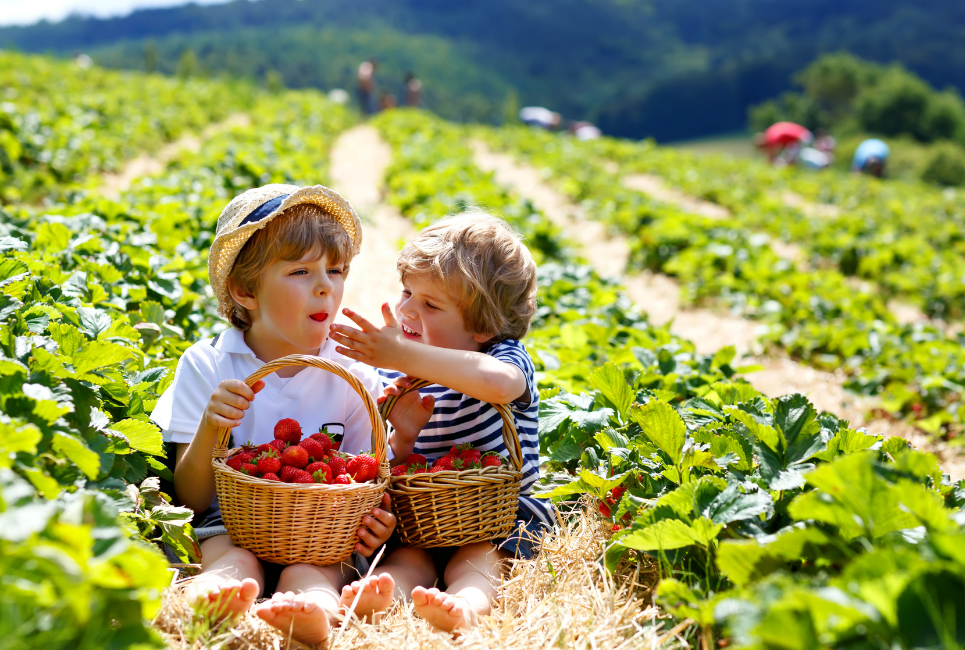- Best Blueberry Companion Plants That You Should Totally Plant Together - August 13, 2021
- Chandler Strawberry Growing Guide: How to DIY? - August 8, 2021
- Albion Strawberry Growing Guide: How to Enjoy This Fruit All Summer - July 5, 2021
Growers generally agree that the Chandler strawberry has few rivals in terms of taste and appearance. Extra-large, very firm, bright red – Chandler strawberries (Fragaria x ananassa “Chandler”) is a beauty. This variety is not only beautiful; it is known for its intense strawberry flavor.
As a “June-bearing” variety, Chandler strawberry produces only one crop per season, usually in spring and early summer. This pattern is unlike varieties such as Albion, which has strawberries from late spring into early fall. Chandler strawberry is a classic choice for California and Eastern United States gardens. The variety’s heat tolerance allows them to strive in these areas.
Unfortunately, like most plants, botanists had to sacrifice some other qualities when they created this variety. Among these sacrifices – disease resistance, shelf life, and decreased crop yield. This article details some useful information on taking care of this relatively fragile strawberry variety, as well as an overview of the most common diseases and insects.
Useful Information on Chandler Strawberry

Growth Habit and Spacing
Chandler strawberry plants are fast growers. They have a prostrate growth habit. At maturity, they reach 12 to 18 inches (30.5 – 45.7 cm) in height. Similarly, the plants spread of 12 to 24 inches (30.5 – 61 cm).
Consider spacing your Chandler strawberry plants 12 – 18 inches (30.6 – 155 cm) apart. As a general rule, wider plant spacing will deliver the largest berries. Finally, it would help if you spaced rows 3 to 5 feet apart (91.4 – 152.4 cm)
Winter Hardiness
Chandler strawberry plants do best in USDA zones 5 to 8. In the United States, they strive from the lower mid-west and mid-Atlantic down into the southeast. But they also do well in Southern California. This variety of strawberries is not the most winter hardy. For those in Zone 4 (possibly 3), stick to a more hardy strawberry variety such as Albion.
Sun Requirements
Plant your Chandler strawberry in full sun. An adequate amount of sunlight is vital for optimal plant growth. Provide your plants with at least 6 hours of sun each day.
Soil Requirements
Your Chandler strawberry plants enjoy rich, fertile, and well-drained soil. A soil pH level of 6.5 to 6.8 is recommended.
How to Water
To produce high-quality and plump berries, your Chandler strawberry plants will need a good amount of watering.
Water your plants weekly if there isn’t consistent rain. Ensure that the soil is evenly moist but not soggy throughout the growing season. Chandler strawberry plants are not drought tolerant.
How to Fertilize
Feed your Chandler strawberry plants with a high potassium general fertilizer in early spring. A soil rich in potassium is important for flower production: the more flowers your plant produces, the higher the chance of a big crop.
Common Conditions and Pests
Unfortunately, Chandler strawberries are one of the less disease-resistant varieties of strawberry, unlike varieties such as the Albion strawberry.
This is a sacrifice of the great taste and lovely appearance. According to Burpee.com, a reputable and prominent online plant nursery, here are some common diseases that affect Chandler strawberry plants:
| Condition | How to Identify | Cause |
How to Prevent and Treat |
|
Black Root Rot |
|
|
|
| Botrytis |
|
|
|
| Powdery Mildew |
|
|
|
| Red Stele |
|
|
|
| Verticillium wilt |
|
|
|
If your strawberry plants are suffering from any of the above, you may also consider contacting your local Cooperative Extension Service for specific treatment recommendations for your area.
Below is a table of pests and cultural problems which may affect your Chandler Strawberry plants. Note, not all bugs affect all areas – as such, your local Cooperative Extension Service is a valuable resource for more information.
|
Pest / Cultural Problem |
How to Identify |
How to Prevent and Treat |
| Aphids |
|
|
| Lygus Bugs (Tarnished Plant Bug) |
|
|
| Slugs |
|
|
| Spittlebugs |
|
|
| Strawberry Crown Borer |
|
|
How to Mulch
Consider applying a thick layer of straw or a strawberry mulch mat under your Chandler strawberry plants when the strawberries start to form. Providing this layer below the plants will prevent the fruit from touching the soil.
When fruits touch the soil there is a risk of getting spoiled or diseased fruit. You can also use sheets of black plastic mulch, which helps retain moisture and reduce weeds.
The Usefulness of Companion Plants

Consider planting your Chandler strawberry with companion plants. Companion plants help in many ways. They attract pollinators, control pests, and fill up available space. Also, the right selection of plants can help boost the quality and quantity of nutrients in the garden bed.
Choose your companion plants based on your climate. Several vegetables, flowers, pulses, and herbs grow well alongside strawberries. You can plant them with asparagus, peas, spinach, lettuce, onion, garlic, and rhubarb for zones with cooler summers.
Beans make quite the giving companion as they improve the soil by fixing nitrogen. The nitrogen, in turn, feeds the strawberry plants and promotes abundant foliage. Some flowers are good at attracting pollinators. Some include borage, chives, and thyme. Pollinators such as bees and butterflies are attracted to these plants.
Pollinators help to cross-pollinate among plants, thus boosting fruit production. Another benefit of herbs is that their potent oils tend to repel pests. This is great for your insect-prone Chandler strawberries. A classic combination is marigolds and strawberries. Marigold beautifies the garden bed and helps to prevent pests. Marigolds have beautiful and opulent blooms in colors from yellows to oranges to reds.
How to Harvest
Chandler strawberries are short-day June-bearers. This title means that they produce a single large crop in spring to early summer. In areas with milder winters, Chandler strawberry plants will bear fruit as early as March.
How to Prune
For strawberries planted in late summer, remove any flowers that form during the first year to encourage next-year fruiting. Producing blooms and fruit stresses the plant and takes up plenty of vital nutrients. By following this practice, your Chandler strawberry plant has many flowers if they don’t get too much stress in the first year.
After the annual harvest, remove all old leaves with hand shears. Be careful not to touch the crown (the visible center of the plant). Pruning allows beneficial sunlight into the center of the plant.
Where to Buy Chandler Strawberry Seeds and Plants

Chandler strawberry seeds and plants are easy to find – local nursery, garden center, or online sellers. The following are links to some reputable online plant and seed sellers:
- Burpee – https://www.burpee.com/strawberry-chandler-prod003049.html
- Gurneys – https://www.gurneys.com/product/chandler-junebearer-strawberry
- Johnny’s Selected Seeds – https://www.johnnyseeds.com/fruits/strawberry/
- Nourse Farms – https://www.noursefarms.com/product/chandler-1/
- Eden Brothers – https://www.edenbrothers.com/store/strawberry-plant-chandler.html
Some online sellers and nurseries only ship Chandler strawberry plants from late winter into spring.
FAQ
Answer: Chandler strawberry strives in warm climates. The plant originated in California and is recommended for gardeners in the southern United States. Chandler strawberry does best in USDA zones 5 to 8; it is unlikely to do well in near-tropical south Florida.
Answer: Chandler strawberry will only bear one crop per year. However, the month varies based on the climate: the warmer the region’s winter, the earlier the crop. In zone 8, it is likely to produce a crop in March. But in some areas of zone 5, Chandler strawberry will not have a crop until the end of June.
Answer: Pick the fruit as it ripens; it should be entirely red. Pick the berry with a short piece of stalk attached. Regular picking may help keep your plants fruiting during the relatively short bearing season.
Answer: Chandler strawberries are delicious straight off the plant. They can keep for up to a week in a refrigerator, but they must be kept dry. Chandler strawberries freeze well and make tasty preserves.
Answer: Yes, you can get fruit in the first year. But, it is always better to remove all flowers you see until the end of June.
June-bearing strawberries such as Chandler should not be allowed to produce in the first year. Allowing plants to bloom the first year will severely reduce the number of strawberries you will get in the following harvest.
Answer: No, you do not need to plant another variety. Chandler strawberries are self-pollinating/self-fruiting – they do not need another type of strawberry to produce good fruit. They make excellent quality fruit just fine on their own.
Final Thoughts on Growing Chandler Strawberry
The Chandler strawberry has very few rivals in terms of taste and appearance. However, there are two distinctive characteristics of this variety that you should consider before planting. Firstly, it is June-bearing; roughly, the bearing season lasts about a month or even less. This period can be anywhere between March and June, depending on how warm your local climate is.
Secondly, Chandler strawberries are prone to diseases and pests. You will have to take particular precautions to ensure that your strawberry beds are protected from some of the common causes of disease, such as – excess humidity, poor crop rotation practices, and fruits touching the soil.
But, if you are a seasoned strawberry grower and don’t mind taking some extra precautions. But this variety’s good qualities make up for the associated hassle. Chandler strawberry is a good choice. They are firm, large, beautifully shaped, and always sweet.

